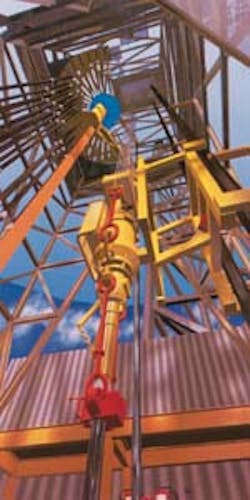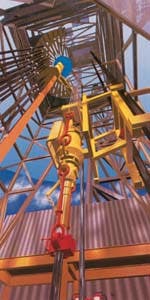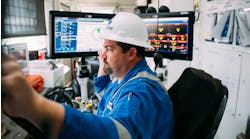DRILLING AUTOMATION Derrick equipment set widens scope of operations on Brent C drillfloor
Bottom view of the new Shell Brent C platform derrick.
A highly automated derrick equipment set will be commissioned by Shell Expro for the Brent Field redevelopment in the UK North Sea. The package, destined for the refurbished Brent C platform, has been designed to further safer and more economical drilling operations on the field for the next 25 years at least.
Design and construction was managed jointly by Bentec, formerly the engineering arm of drilling contractor Deutag, and UK fabricator Consafe. The completed equipment recently left the latter's yard in Burntisland, Scotland.
Shell decided that the platform's existing drilling rig, although equipped with a modern top drive system, was too old for reliable performance long term. It wanted a more automated replacement with lower manning requirements, and which would occupy less space on the skid deck area, leaving more room for simultaneous workover operations.
Bentec had already proven its expertise in this field through a land-based, semi-automated rig installed in 1990 Windeschenbach, Germany for the KTB continental deep drilling project. That rig, which featured 4,000HP gear-driven drawworks supplied by Wirth, made 700 round trips to depths of 9,000 meters during four years' operation, with no stoppages.
Total shutdown time for the KTB rig was just 1.6%, including maintenance. This performance convinced NAM to order a similar automated rig from Bentec for its land-based Prostar 2000 project.
Space saving
Brent C's new drilling module will occupy about half the space and volume of its predecessor. Equipment from the previous system has been integrated with the new rig, including pumps and mud tanks. The latter will be located in a complete mud treatment facility housed in a modular container structure spanning the existing platform skidbeams.
The control center for the replacement rig, known as the New Derrick Equipment Set (NDES), is situated in front of the drawworks, giving an all-round view of the drillfloor and piperack to the drillers. Automation of drillfloor pipehandling equipment is provided through de-centralized programmable logic controllers (PLCs).
The derrick features two guide rails, a retractable dolly top drive, and remotely controlled star fingerboard. At the rear of the pipedeck a knuckle-boom pipehandler with gripper controls handles pipes on and off the horizontal pipehandler. The combination of conveyor, drillfloor pipehandler, iron roughneck, and mousehole arrangment allows making up and breaking out drill pipe stands while drilling.
The Bentec/Wirth also supplied the NDES' 2,000HP drawworks as a direct coupled, gear-driven unit with three braking systems. Normally, an eddy current brake is the main braking device, but NDES features a four-quadrant SCR system. This allows regenerative braking of the drawworks' DC motors, which is the primary source for braking and uses the eddy current brake as a backup.
Two extra 22kW AC motors in the drawworks aid positioning during drilling. Their speed is controlled by a feed off control system in the NDES control center. This arrangement allows for constant weight on bit, controlled torque, and controlled rate of penetration.
The NDES design team have automated most repeatable drilling operations, which should reduce risk of accidents to personnel. Each major pipehandling equipment item can be operated automatically through decentralized PLC systems, but automation is not so entire as to prevent the driller interfacing directly with the process if required.
Ergonomics is another important feature of the control cabin, the layout being arranged to give the driller and his assistant comfortable control of drilling and pipehandling as well as monitoring of drilling processes throughout the rig. Drillers' comments to date have been favorable, according to Bentec.
The supervisory rig remote control system also manages anti-clash and work coordination, ensuring that two or more drillfloor equipment items are not placed in the same location at the same time.
Brent C's top drive retracts away from the well center, providing access for the drillfloor pipehandler. The top drive can then be moved up and down the derrick without obstructing the pipehandler or iron roughneck.
To aid precise positioning of the hook, an automated drawworks control system has been developed which stops the traveling assembly clashing with the crown block or the drillfloor. The driller can thereby define the upper and lower working limits by means of PLC controls, allowing the system to repeat the operating locations for the traveling assembly when needed.
Engineering, procurement and testing at Consafe's yard will have been completed in 15 months. Load-out will be next spring to the Brent C site and will be assembled in two quick lifts. Once installed, drilling can begin fairly swiftly down to depths of 3-4,000 meters. The installed NDES will stand 62 meters high and weigh 1,300 tons: the benefits should include manning requirements 12% below the previous arrangement.
Copyright 1995 Offshore. All Rights Reserved.




